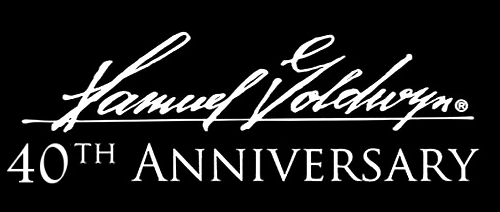|
|
 |

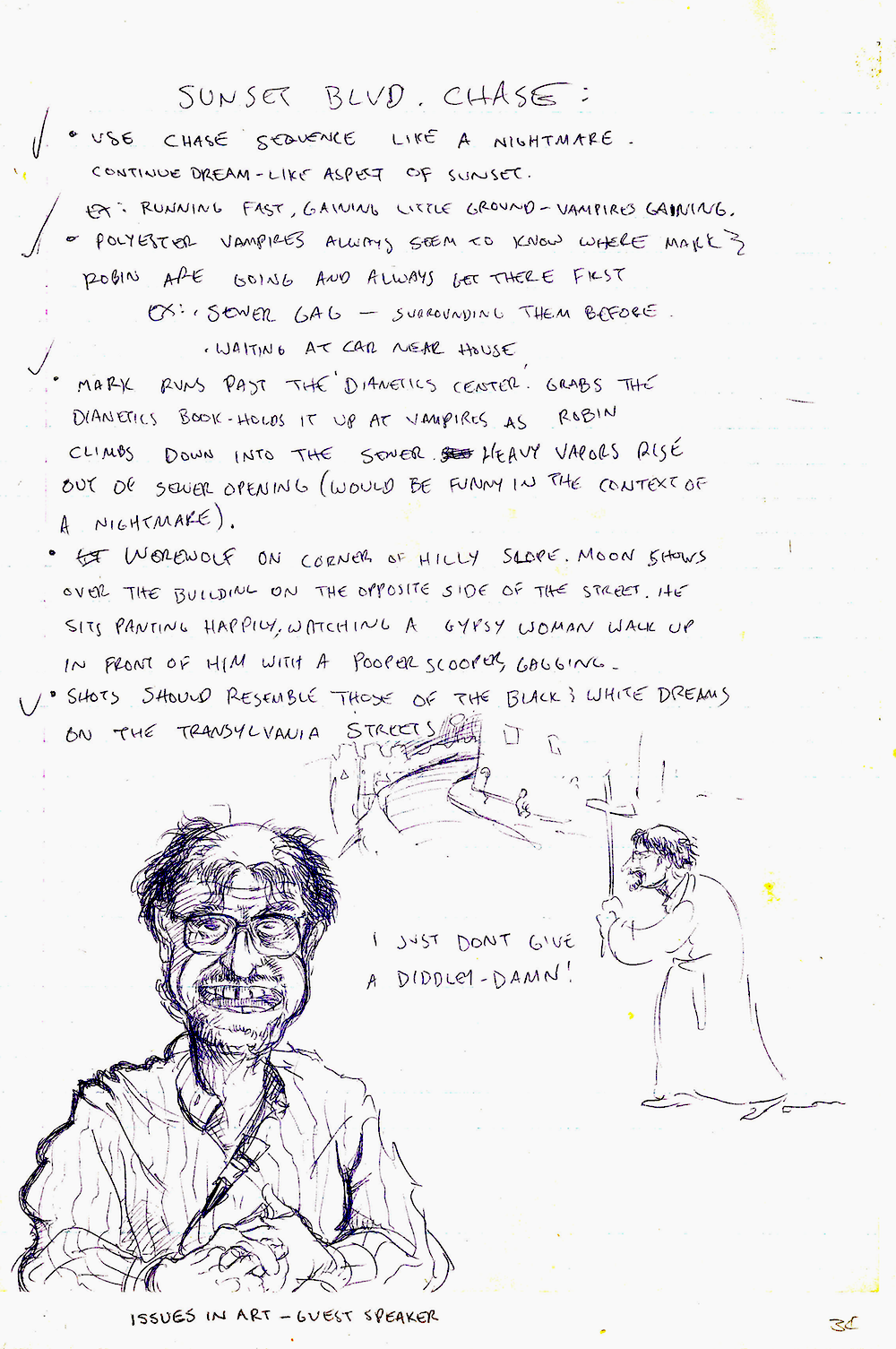 |
In 1983, I was in college, studying to become either an illustrator, sculptor, or animator—I couldn't decide which. My political cartooning aspirations had been dashed due to poor study habits (I won an award for the best newspaper cartoon in the state at the college level that year, while still getting a "D" in my journalism class).
Anyway, while sitting around in my dorm room at Long Beach State, doing nothing but avoiding the dreaded decision of my ultimate career choice, I wrote a screenplay for $2000 (that's TWO thousand—not twenty thousand, not two hundred thousand) with my old friend Dave Hines. It was called Nightlife, and was about a teenager who gets bitten by a female vampire in Hollywood. From this tiny seed, even tinier seeds would grow. (Here is the first act.) At right are my class notes from an "Issues in Art" lecture, in which I mapped out the final chase scene for the script, taking place on Hollywood Boulevard, with the heroes trying to hold off vampires with copies of "Dianetics" in front of the Scientology building. I even incorporated the class's guest speaker, with the weird balding pattern, as a priest.
Meanwhile, I was nearly killing myself in an attempt to avoid a career choice. I took twelve units of illustration classes, then another ten of sculpture—two full class loads—just to avoid making an ultimate decision. Between 16 hours of schoolwork a day and writing the script, I was wandering around in a fog, wearing ink-and-clay-stained pink clothes (I hadn't yet grasped the washing complexities of separating bright red shirts and tan pants). Before long, I developed pneumonia. I grew dark rings under my eyes, lost 15 pounds, and ground my teeth into the jagged nubs they are today.
In the midst of all this, I also experienced a mild nervous breakdown as the result of a failed love affair with a girl named Robin. I couldn't figure out why a buxom, astonishingly beautiful 20-year-old Rose Parade princess didn't find me (a skinny, unastonishingly ordinary-looking 21-year-old art student) to be suitable marriage material—a problem that still vexes me to this day (as does separating the reds in the wash). Anyway, we named the lead female character in Nightlife after her, and the male lead was named after Dave's nephew—a truly great kid who had passed away from leukemia. (Dave was honoring a tragic death while I was just trying to impress a girl. Me, shallow? Oh yeah...) Here's a drawing of Robin that I did as she studied in my dorm room:
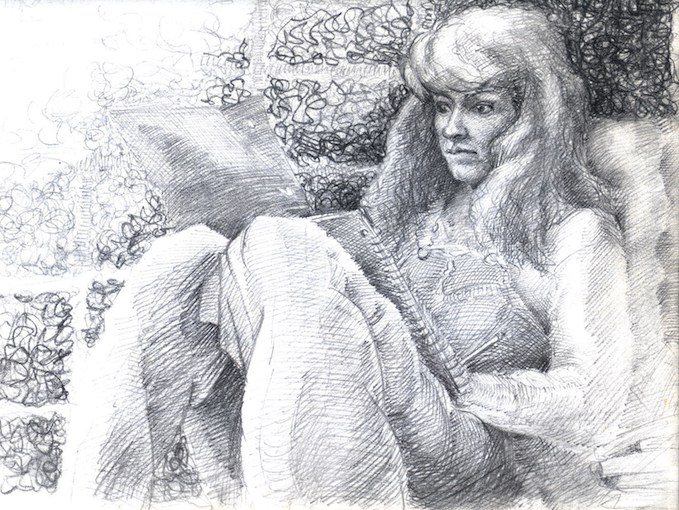
Needless to say I was in no shape to make any major life decisions. So, to my surprise (and relief), somebody finally made the decision for me. Samuel Goldwyn Jr. bought the rights to Nightlife, but demanded a rewrite to make it more commercial. He also demanded full-time writers, saying that if I stayed in school he would simply hire someone else to take over. What can I say—the loss to the sculpture, illustration and animation worlds is the screenwriting world's loss, too. I jumped at the chance.¹
 |
Calvin Yocum was a product of Yale University and a reader for the Samuel Goldwyn Company. He was infamous among the Goldwyn execs for being the toughest reader they had—he even panned Dr. Zhivago. According to them, Calvin hated everything.² But to the amazement of everyone at the Goldwyn Company, he loved our script, to the point that it got us our first spec sale. His coverage was so gushing that Samuel Goldwyn Jr. actually showed Calvin's write-up to us one day at the Friars Club. I still have a copy. Here is the summary to Calvin's notes:
COMMENTS: This script is absolutely hilarious, sort of a Rocky Horror Picture Show meets Blazing Saddles with a little Airplane! thrown in. No mere synopsis can convey the goldmine of humor. Besides the story itself, there are dozens of sightgags thrown in to keep things jumping. Literally, there is never a dull moment. It's no-holds-barred comedy that pushes the boundaries of good taste at all times, but it is exactly that kind of demonic energy that makes it all so inspired. The writers create a Fellini-esque vision of Hollywood that reeks not only of comic atmosphere but somehow captures and hyperbolizes our worst fears about the sleazy parts of town. It is a vision that balances precariously and triumphantly on a razor blade. It is funny, but with a few minor changes, it could be visually and intellectually serious enough to rival Satiricon or Coppola's Rumblefish. The high school takes all of the not so latent fears of our own experience -- especially the fear of ostracism -- and hyperbolizes them and satirizes them wildly. There are a half-dozen other bits like the disco gypsies and the Redemption Center that score too.
In the right hands, this script has enormous commercial potential. Certainly it is 180 degrees from the serious and wholesome intentions of The Golden Seal, and it may not be the type of project that interests the Goldwyn company. Nonetheless, in its genre, Nightlife is superb.
HIGHLY RECOMMENDED. |
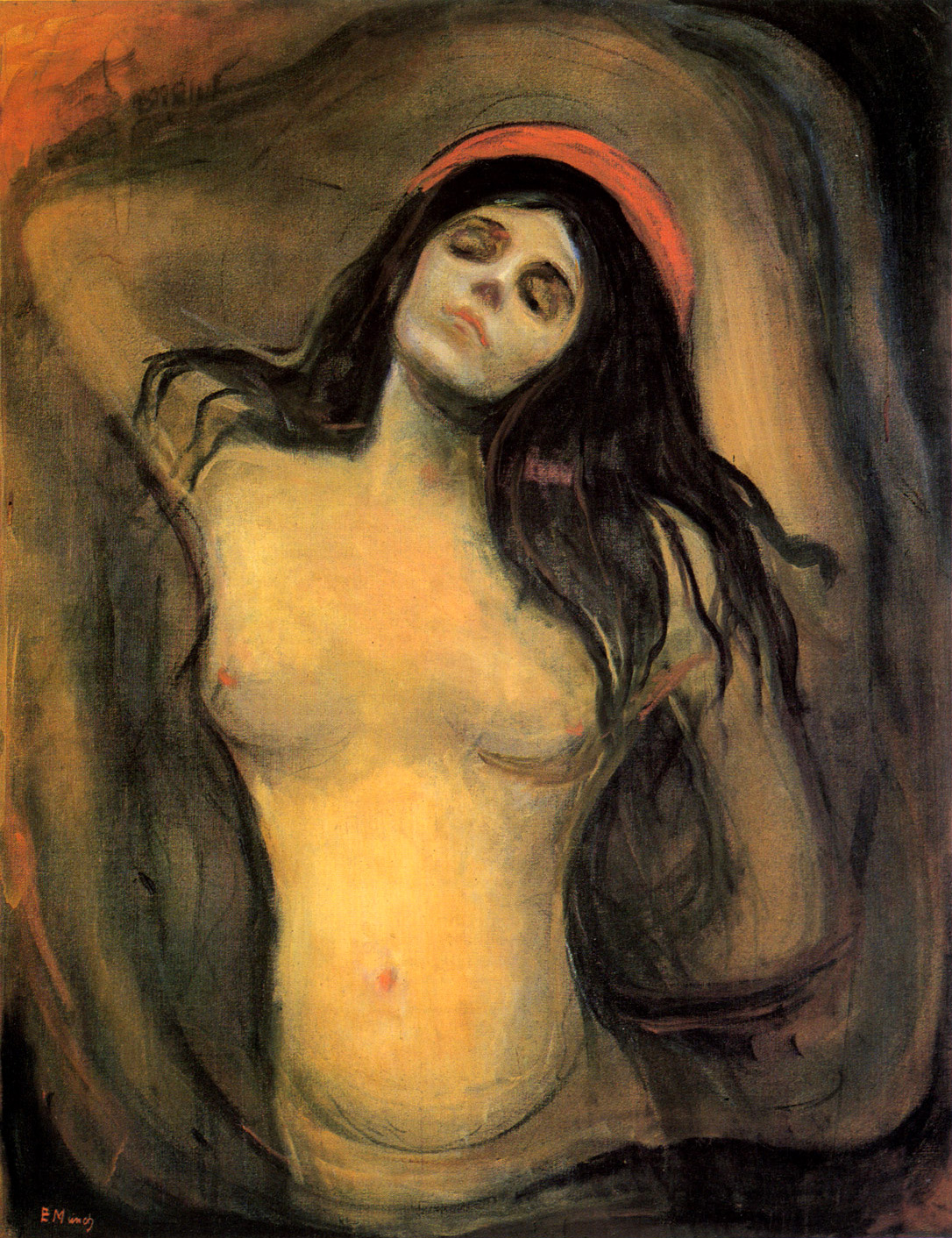 |
Now most people in show business, out of show business—hell, out of kindergarten—will tell you that when you sell a screenplay in Hollywood you need an agent to handle the deal. Fools! Imbeciles! Giving ten percent to some leech who is just glomming on to your pay after you've done all the hard work? Never! Dave and I handled the negotiations ourselves. (We'll get to the actual numbers later...)
We were given an office two doors down from Sam Goldwyn Jr. himself, overlooking the Beverly Hills Country Club, with a view of the Hollywood sign in the hills behind, and a hotel room at the fabulous Tropicana Motor Hotel, just outside of Beverly Hills (they put us in a hotel just outside of Beverly Hills because it was half the price of a hotel inside of Beverly Hills). Other than having to listen to Joan Jett and Billy Idol trash their rooms next door every night, it was a dream come true... until Dave's fiancée told him to come back to Vista (our hometown), where they lived in a converted chicken coop on her brother's property (no, that is not a snide exaggeration—they really lived in a converted chicken coop). If he didn't return, she was going to fly the coop and he would lose her forever. So we gave up the Beverly Hills office and the just-off Beverly Hills motel room and drove back to San Diego County. We were young Fellinis, damn it! We didn't need supervision any more than he did!
Two months later, we triumphantly drove back up to Beverly Hills and turned in our first big-time Hollywood movie rewrite. We were confident... even cocky. We presented the script to producer Dimitri Villard with lit candles on the cover to celebrate his birthday. Unfortunately, Calvin Yocum's story notes had gone to our heads (we were young Fellinis, damnit). Eschewing commercial concerns, we turned a light teen comedy about sex and vampires into an allegory for herpes, the dreaded scourge of humanity. (Ah, the good old days—now people are relieved when they find out they only have herpes.) We decided that the look of our teen sex film was to be inspired by the dark, brooding artwork of Norwegian expressionist painter Edvard Munch. I wish I was joking about this, but I'm not. (Side note: There is still a portrait of Lauren Hutton in the finished film based on the Munch painting shown at right, variously titled "Madonna" or "Vampire," painted in 1895.)
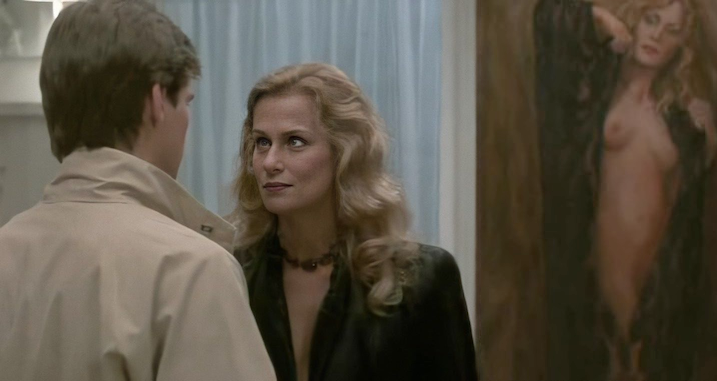
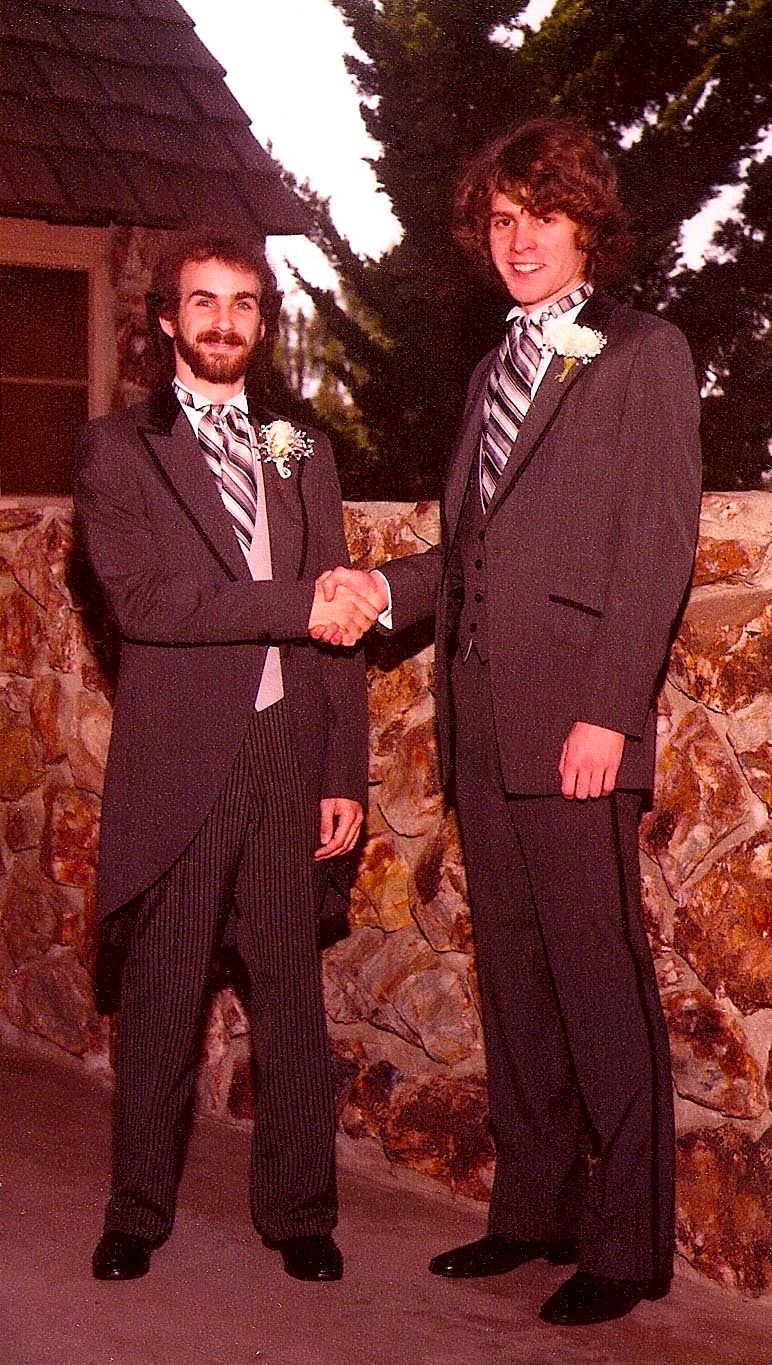 |
Sam Goldwyn Jr. wanted to fire us the next day, but Dimitri lobbied to keep us on board. Thanks to his intervention our jobs were saved... whereupon in a complete lapse of logic, Dave decided this was the perfect time to finally marry that fiancée and drive off on a Disneyland honeymoon (in his defense, with our heads on the chopping block he understandably preferred Fantasyland to reality). So while he had a romantic honeymoon getting sick on the teacups I sat through a story conference with the producers and Goldwyn execs... Actually I just got yelled at for two hours. Dimitri didn't even yell—he just shook his head and dropped the screenplay on the floor like so much trash.
Our tiny paychecks were canceled before they could clear at the bank, and we lived on nothing for the next three months until a suitable rewrite was turned in. I drove that draft up myself, bringing the real Robin to the Goldwyn offices to supply extra sex appeal. Three of the producers read the first twenty pages on the spot as we sat in Russ Thacher's office. I assume they were all there to fire me on the spot if they didn't like it. Fortunately they were laughing, relieved, and declared the screenplay salvaged. (Which was fortunate, because when they asked the real Robin what she thought, she answered that her character was under-developed!!! They didn't agree... or agreed but didn't care.)
Over the next two years we went through four or five more rewrites—amassing a grand total of about ten grand in pay, combined. (Mom and Pop must have been so proud of their non-college graduate son.)
There are plenty of great stories that I could relate that happened during this period: For instance, the time we tried to drive into the Beverly Hills Hotel in Dave's beat-up '62 pick-up truck to meet the director, Howard Storm, and the valets wouldn't let Dave's wheezing, shaking, twenty-year-old piece of junk into their parking area—they waved us off and yelled "the service entrance is in the back." (A recreation of this event also appears in the film, with Jim Carrey driving an ice cream truck.) If the valets weren't mad enough about the size of our tip, the fact that the truck then stalled and blocked the entrance from the other customers for half an hour sent them over the edge into a fit of cursing never before heard at the stylish, dignified entrance of a four-star hotel.
Or there was the time I went to a story conference while having an appendicitis attack. I couldn't even stand up straight for the meeting (I guess the producers just assumed I was groveling). My appendix exploded that night and I nearly died on the operating table—and the next morning one of the producers called my hospital room and asked when the rewrite was going to be ready.

Anyway, after a year of similar episodes the script was finally approved. We were still agent-less and still nobodies in Hollywood, but we were going to get a real MOVIE made! Unfortunately, all of our allotted pay had been used up in financing the rewrites, so we were also broke. There was only the satisfaction of having written a sex comedy about a 17-year-old virgin getting bitten in the crotch during oral sex from a female vampire, for an intended audience of 13-year-olds without parental supervision. I was quite proud. We did receive a $6,000 bonus on the first day of shooting, which I immediately blew on a Dodge Daytona Turbo. (Hey, I was 21.)
CUT TO:
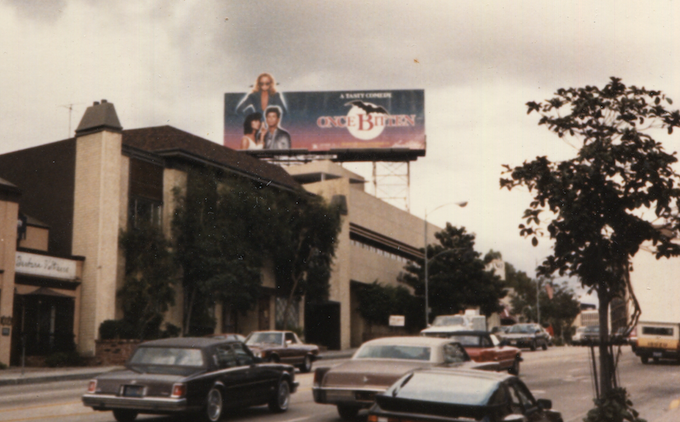
 |
A year later: The film, now titled Once Bitten—and heavily rewritten by the director and his own writer—opened in theaters to embarrassingly negative reviews.³ On the bright side, it was the #1 movie in the country on its opening weekend, raking in $4,025,657 in 1,095 theaters for a $3,676 per-screen average (beating out my boyhood idol Charles Bronson in Death Wish 3). According to "Box Office Mojo," it still ranks as the #37 all-time film in 'Fewest Theaters to Debut at #1' (is that an insult or a compliment?), and is the 11th highest-grossing film ever made by the Samuel Goldwyn Company. It had its own billboard on the Sunset Strip in Hollywood (shown in the photo, above), and it was even condemned by the Catholic Church. (Cool!!!)
But after that, the film sank pretty quickly in a sea of rival, identical teen sex comedies. All of the special qualities that Calvin Yokum had praised in our original script had been systematically weeded out: The filmmakers were more interested in recreating generic teen-film formulas than rocking the boat with anything untested or different.⁴
Originally our script portrayed Hollywood as a dark, seedy, soulless place—filled with crime, zombie-like transients, spike-haired punks, and Goth weirdos, where a vampire could blend in and never be noticed (the film still uses that explanation in a bookshop scene, but now it doesn't make any sense, because it's shown to be a glamorous place). The director, a TV veteran who had helmed episodes of Taxi and Mork & Mindy, got rid of the "Fellini-esque" elements in the script. He changed it to a vampire version of Mork and Mindy, dropping a fantasy figure into the suburbs (the difference being that the fantasy figure was played by a comic genius in one project and a supermodel with no comic training in the other). He replaced the opening sequence in the seedy downtown Hollywood area with a splashy music video-style montage in Beverly Hills, and replaced my favorite carnival scene (Carrey's character is stalked by the vampire through the House of Mirrors in a run-down amusement park—where she can see his reflection in the glass as she chases him through the maze, but he can't see her) with a single mirror in a changing booth at a trendy shopping mall clothing store.
Before Goldwyn was involved, the Countess was going to be played by Cassandra Peterson (TV's "Elvira") as kind of a scrappy, hard-working vamp stuck in the worst part of town, searching for lost innocence. On the left of the image below is a sketchbook drawing from when I was trying to visualize scenes for the script. This is how Dave and I envisioned the bar in the film: It's dark, she casts no reflection in the mirror, and a spider is stealing the cherry out of her drink. (How symbolic!) On the right is Lauren Hutton, playing a rich Beverly Hills MILF (a generic role for teen sex comedies of the time, usually played by Sybil Danning or Sylvia Kristel—or Jackie Bissett for a studio project) trolling for teenagers in a much more glamorous bar than we had originally pictured. Not a spider in sight.⁵
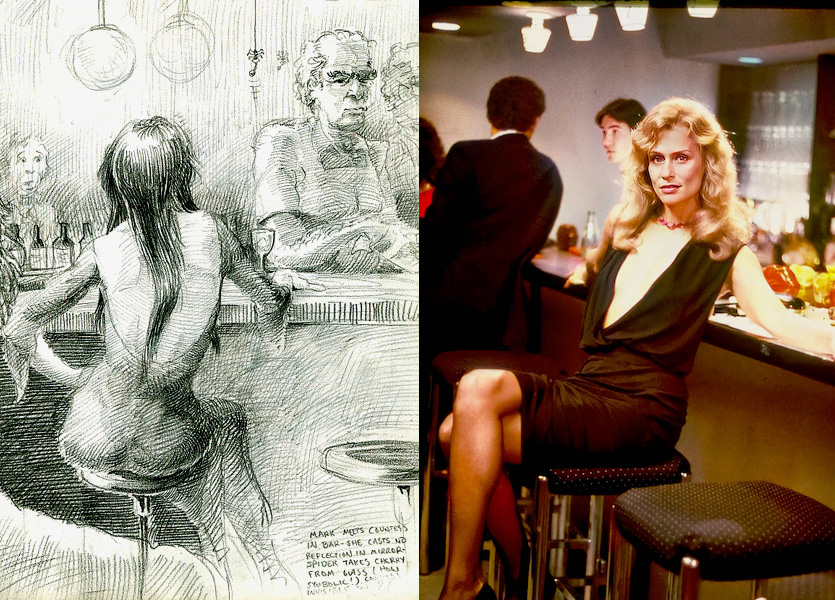
The filmmakers, being wealthy middle-aged men, couldn't remember far back enough to explore how frightening it was to lose your virginity, and never ventured into the part of Hollywood that we described. They preferred to have Hollywood seen as a glamorous hotspot with bright lights, fancy cars, fast women and slow-witted teenagers—like Beverly Hills—and deal with the issues that THEY found scary: Aging, gay butlers, and teenagers breaking into spontaneous break-dance routines on Rodeo Drive. Once Bitten may be the LEAST scary-looking vampire film ever made. The Countess lives in a brightly-lit, faux-palace featuring immense open, western ranch-style rooms with post-modern lacquered furniture and huge windows to let the sun in; Vampires stalk neon-filled Hollywood streets teaming with klieg lights and simulated beachfront photo shoots with supermodels; Shadowy nightmare sequences were cut in favor of all-white, brightly-lit, "modernized" scenarios with no comic ideas or punchlines. Our jokes were still there, but the tone was completely different. "Anemic" was the favored critical insight (I will say unhesitatingly that the three or four genuine laughs left in the film are from Dave and me, but the shift from a vampire movie invaded by teens to a teen movie invaded by vampires really did it in).⁶

The film starred Lauren Hutton (who was much better than the part, giving the film some naturalism and sophistication) and, in his first major (?) screen role, a young Jim Carrey. (You can see how the makeup department really went to town on this film: To transform Carrey into a vampire they... slicked his hair back!) The film debuted in the number one slot on the charts in Variety. Dave and I even appeared IN PERSON at a San Diego County theater, where we signed posters for the audience members. Everybody called and congratulated me, telling me how proud they were. I was proud, too: I was at least partially responsible for a multi-million dollar endeavor, and millions of people were seeing my work. And I pondered that amazing fact every day of that opening week as I drove past the theater marquee.....
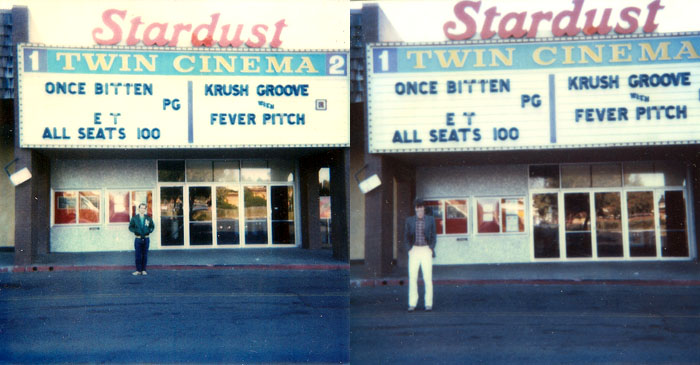
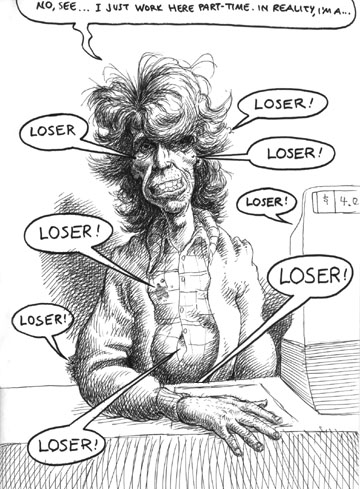 |
..... on my way to work at Sam Goody, earning minimum wage as a clerk in the video section—feeling like the biggest friggin' loser on the face of the planet. (The drawing at right is from my sketchbook at that time.)
If that wasn't humiliating enough, the film came out on video six months later and my co-workers had to point me out every time the movie was rented by a customer ("See that guy vacuuming the carpet over there? He wrote it!!!"). Worse yet, if I concealed my identity then I had to listen to the customers' rotten reviews of the film when they brought it back (one unknowingly offered, "Whoever wrote this shouldn't be working in Hollywood". I screamed back, "YOU GOT YOUR WISH!!!")
When that became too embarrassing, I started delivering The Los Angeles Times—which gave the film its one good review—tossing 300 papers every night in dejected anonymity while driving my brand new Dodge Daytona Turbo.
On the bright side, I've now made more money in residual checks from that film than I ever earned writing it (despite all the headaches we caused, Samuel Goldwyn Jr. gave us a point and a half of his royalties—the same amount the director got), and I have an agent now who once got me twenty times the amount I was paid on Once Bitten for a script that was never even filmed (you tell me that Hollywood isn't screwed up). Ironically, it was a project about a half-man/half-cartoon, but was finally canceled because a rival film had beaten us to the punch—called The Mask... and starring JIM CARREY!
To really be honest, I've actually begun to enjoy telling this pathetic story—I can always trot it out for sympathy. Plus, I later learned that Jim Carrey had a much worse time on the film than I did: Terrible family trouble, career trouble, romantic trouble—I just hope the poor bastard came out of it all right.
|

UPDATES: My writing partner has reminded me of a few more anecdotes that don't really fit into the above story:
ANECDOTE #1: I had originally campaigned for an actor to star in the film who was featured in a little-watched TV show getting killed in the ratings by Magnum P.I. The show was Family Ties and the actor was Michael J. Fox. I sent Sam Goldwyn Jr. a videotape of Fox, but Sam felt he would never carry a big screen film (Back to the Future opened about two months before our film and grossed $200 million, and the film Fox did instead of ours, Teen Wolf, grossed about $70 million more than our film, despite being no funnier, nor scarier—but it had Fox, naked boobs, and actual monster makeup).
On the bright side, they cast Carrey, an unknown comic, in Fox's place. At the time, the director wanted Carrey to co-star with Morgan Fairchild. I went ballistic (translated: I moped a lot), because Morgan Fairchild is about 4 feet tall, and could never convincingly menace Carrey—about six feet, fourteen inches tall—onscreen. Eventually they cast Lauren Hutton in her place.
My gripes about the snubbing of Michael J. Fox aside, when I finally visited the film set at the Whisky in Hollywood, it took just one scene for me to be totally blown away by Carrey. We had written a dozen sleazy LA bar sight gags into this scene—all cut—but Carrey just had to walk across the bar and look scared: Somehow he made that funny! Every line delivery was fresh and original, and he knew how things looked on camera without having to look through a lens. While much of the comedy in our screenplay had been removed or compromised (the director had even cut jokes to "give the audience more time to laugh" at the previous jokes), Carrey didn't need our sight gags or punchlines—it was overkill. We had no idea while writing inside that crumbling chicken coop for two years, over-cramming the pages with sight gags and post-ironic snark to protect our story from incompetent filmmakers, that we were actually writing for an authentic comic genius. We didn't need those gags—we needed another month or two to rebuild the screenplay around Carrey... but that was impossible, so he had to carry it all by himself (witness the dance scene). No matter how much of our stuff was removed, the humor in the character was still there, intact, without the punchlines. Carrey was the punchline. After watching Carrey work I admitted to producer Russ Thacher that they were right to cast Carrey, after all (he just smiled, patiently, as he always did). He then introduced us to Carrey, and we talked for half an hour, about how I liked him on The Duck Factory, a sitcom about an animator that he had starred in the previous year. Then we left to be interviewed by the publicist... who informed us that the director and his writer were filing for arbitration with the Writers Guild to take away our screen credits.
I stewed over being further marginalized by these jerks during the course of the publicist's interview ("Good," I thought. "The script sucks now, anyway. Let them take the blame!")... Then, as Dave and I were leaving, I spotted Jim Carrey near the catering truck. I walked over in order to say so long... now, I wanted to say, "I think you're incredible and I hope we can work again on a new project," but in my anger it came out as, "They butchered our script, the director's incompetent, this movie is going to suck, and you're the only good thing left in it." Just what an actor wants to hear in the middle of a shoot—that the film sucks! (You can't say I was smart—but you can't say I was wrong, either...) It probably got me barred from the set, but we never went back again, anyway. We just stayed home and worked on our next script for Dimitri and Robby. We took one meeting in Los Angeles with a director named George Mendeluk and were offered the job of writing what eventually became Meatballs III. When the production team asked us about our representation in order to make a deal, I told them they would have to call my mom. They laughed heartily, not realizing that I was serious. (Being young Fellinis, we turned them down anyway, in order to write a spec.)
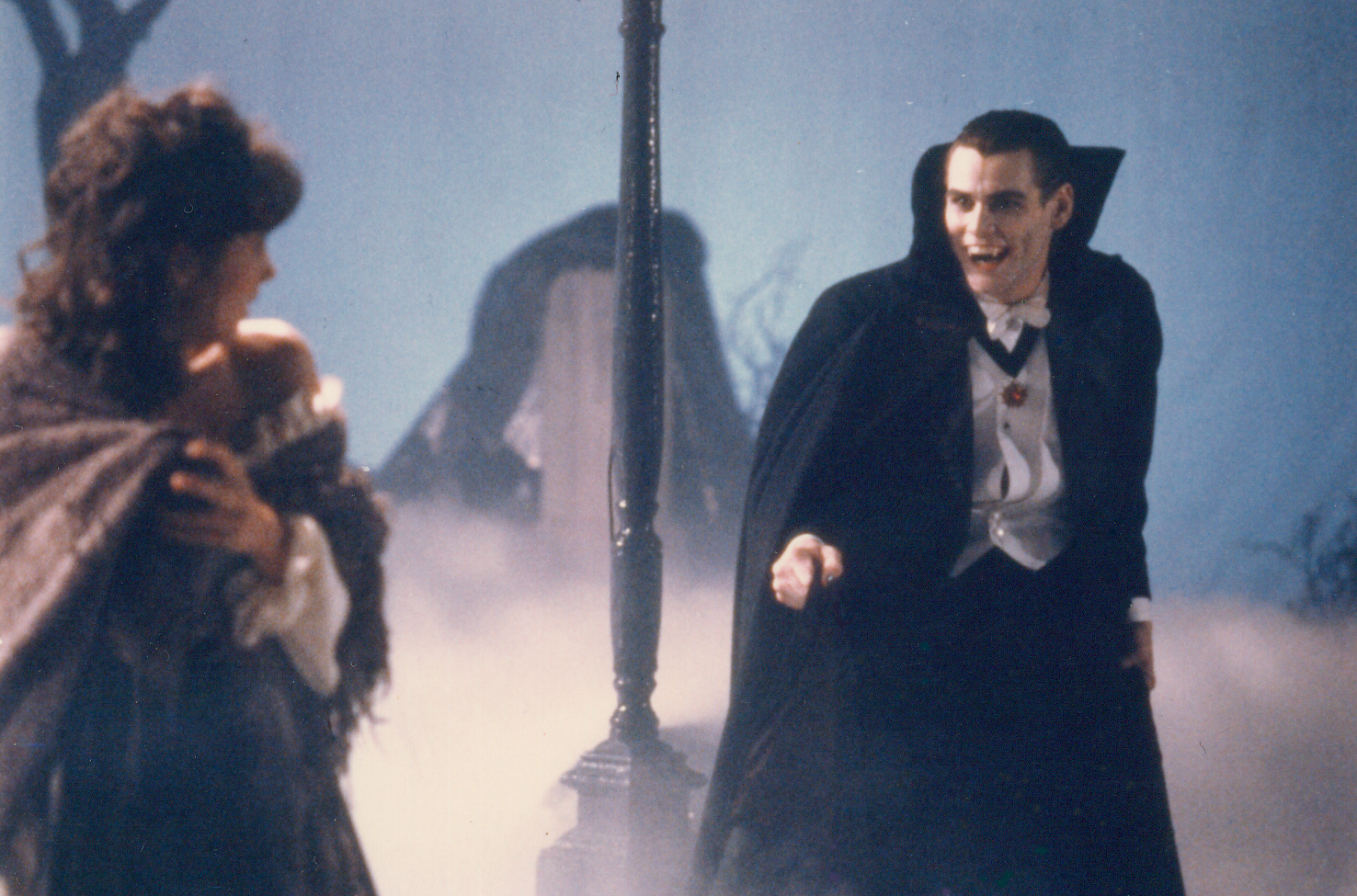
ANECDOTE #2: Because we never returned to watch the filming of "Once Bitten" after the incident at the Whisky, I never met Karen Kopins, who wasn't in that scene. We had originally pushed for Valley Girl star Deborah Foreman to play Robin, but here are five reasons why Karen Kopins was awesome in the film:
- She was so good that Goldwyn inserted her image into the theatrical poster at the last minute, because of positive audience response at test screenings.
- She was the only participant in the dance scene who could actually dance.
- She didn't know how to pull her punches, and hit one of the vampires so hard during the chase scene that she knocked his prosthetic teeth out.
- She has the best line in the movie, strictly on her delivery. I had swiped a line from The Seven Year Itch, one of my favorite movies, for the character of Robin. The original line is recited by Tom Ewell in that movie to a guy he thinks is seducing his wife. It goes, "Helen loves me because I'm nice! And sweet! And kind!" and Ewell then punches the guy in the mouth. I changed the line to, "Mark doesn't want you because you're mean and evil. He wants me because I'm nice and sweet and pure... so fuck off!" Her delivery was perfect—even better than Ewell's, or anything that I had imagined when I first swiped the line. She didn't even need to punch anybody (thank God—see point #3). Sadly, most people don't get to hear her pure, uncensored version on broadcast TV. It's the best reading of a line of my dialogue, ever (or George Axelrod's).
- I mean, come on—just look at her!

ANECDOTE #3: The time during a story conference in a restaurant when one of the producers, Robby Wald, wanting to keep a gag from the original drive-in opening concerning a Black & Decker vibrator with a pull-cord, actually got down on his knees and loudly begged a studio executive to, quote, "put the vibrator back in." (Which was much funnier than the gag he was fighting for.)
ANECDOTE #4: The time I came close to physically assaulting Samuel Goldwyn Jr. after a preview screening when he removed a gag from the finished film (translated: I moped a lot... although I did yell in his face for about three seconds as he stood by his limo). The original gag had Carrey admitting his sins to a homeless man instead of a priest inside a church confessional. He asks, "What should I do?" The drunk answers from the next compartment, "Pass me the toilet paper—I'm all out on this side." (It was actually my dad's joke, and he was at the preview waiting to hear his big contribution. So when a new line popped up instead it really pissed me off.) Goldwyn changed the gag to the bum just saying "You're in deep shit," or something, and claimed he had to do it, or the film would be condemned by the Catholic Church. (It was condemned, anyway—it was a film about an atheist vampire deflowering high school kids, for Christ's sake)... Anyway, you can still hear the bum grunting as he takes a dump while Carrey talks—and a variation of the gag was finally seen a few years later in the Beavis and Butt-Head movie. Big laugh, by the way, Sam.⁷

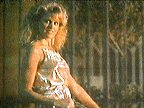 |
ANECDOTE #5: My secret shame: At the time we wrote the script I was in love with a girl (the real-life "Robin"—described above). Robin didn't love me, but she looooved lions. Collected anything with lions—toys, dolls, pillows, figurines, posters—anything short of an actual man-eating lion (although she probably considered getting one of those, too, just to keep me off her). Anyway, it was a big deal in the eighties to have video montages in every film. And this film has a terrible one. They hired some video montage "specialist" to film scenes around Hollywood as the haunting "Once Bitten" theme played over the soundtrack. Really lame stuff, like a "model shoot" on Sunset Strip. (Why are they pretending to be on the beach at night on the Sunset Strip? Not only is it not funny or scary, but the real friggin' beach is only FIVE MILES AWAY!) Anyway, one thing they added—and don't ask me why—was the image of a supermodel walking a lion down Rodeo Drive. We had nothing to do with it. So the film came out, and the real Robin called—THRILLED at the "tribute" to her onscreen. (The supermodel happened to look like the real Robin—who was a blonde, big-haired Rose Parade princess and a real babe.) And me, being the down-and-out, emotionally crippled video store clerk I was at the time, TOOK FULL CREDIT. So, to Robin, if you're reading this out there somewhere, I didn't actually write that scene... But come on, I named the friggin' love interest after you!⁸
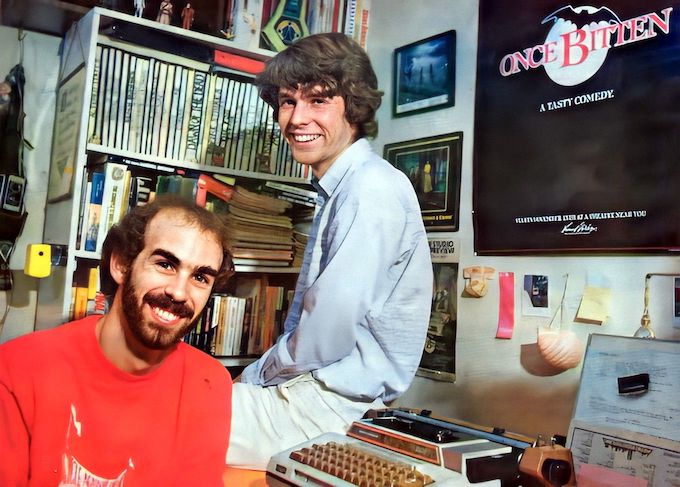

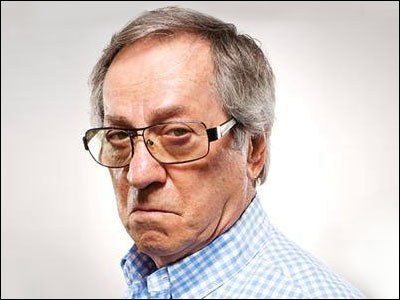 |
Howard Storm Bites Back!
In his new autobiography, THE IMPERFECT STORM: From Henry Street To Hollywood, written with Steve Stoliar, Once Bitten's director challenges my assertions here, arguing that this film is actually... good! Click on the photo to read his recollections, accusingly and dispiritingly referring to Dave and me as "the writers," and read my responses (if possible, read them aloud in a hysterical shriek). To be fair, the material on Once Bitten is only five pages out of 222, and the rest of the book recounts a pretty spectacular life and career. So go for the unfortunate Once Bitten anecdotes, and stay for tales of Robin Williams' brilliance and making films with Woody Allen, and jumping the shark with Garry Marshall. Fun read! |

¹—The same thing happened six years later, when I re-enrolled at Long Beach State, then landed a job at Warner Brothers writing with Rodney Dangerfield—but that's another story, and this one's depressing enough by itself...
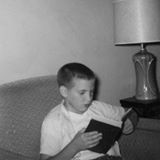 |
²—Not altogether true; Calvin's Facebook page shows that his favorite books are Anna Karenina and Heart of Darkness (the image at right shows him devouring great literature as a child in preparation for reading our screenplay). His Linkedin page says that he became a story analyst at 20th Century Fox, and avoided our work post-Once Bitten like one of those plagues the Countess speaks of in the film. (Here are his full notes.)
³—I have a videotape of the TV as I clicked between channels while the Los Angeles TV critics tear the film apart on the 5pm news. It's merciless. The worst review came a few years later, however. We held a place of infamy in a book about the history of homosexuality in the cinema—the late Vito Russo's "The Celluloid Closet." (The book was first published in 1981, but Once Bitten was included in the 1987 revised edition.) The book took us to task (well, not "us" exactly—just Dave. I was somehow overlooked... which also pissed me off, strangely) for being one of the most homophobic of the many homophobic teen comedies made in the early 80's. The scene that Mr. Russo found especially offensive involved a high school shower, in which Carrey's two best friends—looking for the vampire's bite marks on his inner thigh—find themselves in a compromising position which causes a homosexual panic among their fellow students. The call "Fags in the showers!" goes out, and the showers immediately empty (based on a true story, by the way). Now, whether you think that's the height of humor or not isn't the point. The point is... well, the point is that Mr. Russo completely missed the point. The shower scene depicted common high school (indeed, common, period) attitudes about gays and made fun of them, showing the situation to be completely and totally ridiculous. To quote Calvin Yocum's script coverage, "The high school takes all of the not so latent fears of our own experience—especially the fear of ostracism—and hyperbolizes them and satirizes them wildly." It's not meant to be homophobic—it's making fun of the homosexual panic of dumb teenaged boys. We were making fun of the reaction—not at the perceived act... THE JOKE IS THAT THEY WERE MORE SCARED OF GAY MEN THAN THEY WERE OF VAMPIRES! That doesn't mean we AGREED with them! THEY were the gag, not the act! It wasn't written as a comment on the LGBTQIA lifestyle. But because the word "fag" was used by one of the panicking morons, Mr. Russo found the scene objectionable. It wasn't his only gripe, and sure, the stereotypical Cleavon Little "I came out of the closet centuries ago" stuff was embarrassing, as was the transvestite in the club calling Russ a "sissy," but more for being boring than offensive. And you know what? I didn't write that stuff, and neither did Dave, and to blame us for everything in the finished film is just promoting an offensive screenwriter stereotype. So there, Vito, you writer-phobe!
The amazing thing is that during the critical onslaught in 1985, nobody mentioned this scene as being offensive, and it got huge laughs. Our best review was in the Los Angeles Times from Kevin Thomas, who was actually given a Lifetime Achievement Award the National Lesbian & Gay Journalists Association a few years ago, and he thought it was funny. Most critics just complained the film wasn't funny enough. Many were offended that a 40-year-old woman was seducing a teenager, but nobody accused us of gay-bashing in the shower scene. Our entire script was about ostracism and fear, and was meant to be outrageous: this scene, the confessional, etc., but most of those scenes were whittled away over two years of rewriting, with this being the only outrageous scene left. If it offends people, I'm sorry. I know what it meant to me when I wrote it. If it means something offensive to you, and you want to use this 35-year-old joke to spotlight an issue that I didn't intend, then hopefully it does the world some good. (Just also remember what the book says: Dave Hines wrote it, not me.) In a horrible, sad postscript to all of this, the actor who actually delivered the "Fags in the shower" line, Philip Linton, died of complications from Acquired Immune Deficiency Syndrome like Vito, in 1992.
⁴—Some examples: "Show it don't say it" notes—expanding off-hand one-liners into scenes, such as Russ and Jamie trying to score in a laundromat (which admittedly worked but didn't move the plot) and picking up newly-freed chicks outside a women's prison (which didn't work and was dropped—this is a vampire movie, remember, guys?); A bumbling butler (dropped and substituted with an even dopier gay butler); They also told us, "Robin can't save Mark because it makes him look like a wimp" (so the Countess inexplicably kidnaps Robin in order to lure Mark back to Los Angeles—instead of just taking Mark from the same parking lot); Most of the notes took the characters out of the seedier areas of Los Angeles and dropped them into the suburbs, which made the film look identical to every other teen comedy at the time... and to top those off, "Write some tits into this script—I want to have some fun casting this thing."
⁵—In retrospect, we sealed our own doom with that second draft. Goldwyn probably opted for an old school comedy veteran after seeing how inexperienced and unreliable we were, thinking an old pro would keep us in-line. Unfortunately, Howard was just not that guy. We never met or talked outside of conference meetings, so he was of no help or guidance. We fought with Howard in those meetings for our ideas, won the wrong battles, and in the end, he just used his own writer to add things we wouldn't when we quit. Anyway, one day we received their rewrite in the mail. Not only had they changed the mirror scene, they had added:
- The gay butler, who made comments about seducing pre-teen Little Leaguers (it was cut from the finished film, so now the line ends on the also-unfunny "Chicken McNuggets"—sorry that you lost more ammo, Vito Russo).
- The gay transvestite, who calls Russ a "sissy" when he rejects his advances. (Did the other writers know that all gay people aren't cross-dressers?)
- We had written a part for Vincent Price, as the high school's science teacher, "Mr. Peacock" (named after our college screenwriting professor). He was to be a vampire expert, and explain the ways of the female vampire when Robin seeks his help in his creepy office. This part was replaced with some guy in tanning makeup who fakes an Indian accent as he explains female vampires to Robin in a used bookstore. Why a used bookstore? Why an Indian accent? Why was this considered funny? I have no idea.
- Vampires burst through walls and cement floors with superhuman strength, then get knocked unconscious by A) an open door, B) running into a pillar, and C) getting punched by Robin. They even had Mark and Robin playing "patty-cake" like Hope and Crosby in the Road movies to thwart pursuing vampires (filmed and cut: the lesson being that you should never reference better comedies than your own).
- Worst of all, they had given the Countess a TALKING PARROT! At the end of the story, the Countess finds a virgin trick-or-treater at her door and the Camera pans to the Parrot, who says, "Here we go again!"
Howard's writer, Jonathan Roberts, had co-written a movie we liked called The Sure Thing, but as one of the producers later put it, "We got the wrong co-writer." Roberts actually went on to work on some good projects, so I won't blame him for the finished script. (Wait a minute... IMDb says he worked on The Lion King... featuring a TALKING PARROT... oh, no!) It was so bad that I fell into hysterical laughter on the floor of Dave's kitchen. Dave just put his head on his new wife's shoulder and sighed. Fortunately, the parrot was dropped from the story (after a meeting at the Friar's club between Goldwyn and us that featured an actual shouting match), but then the filmmakers were left without an end line for the film. We were called into the office for a meeting during re-shoots, and I pitched them a line that they loved and used to end the film ("I believe I've created a monster")... and they never realized that it was actually the last line of the draft that they had almost fired us for two years earlier.
⁶—And, let's face it, vampire movies are just plain silly. The whole notion of them being repugnant societal outcasts is ridiculous. If the Countess went on TV and said, "I can give you eternal youth, and all you have to do is drink virgin blood three times," it'd be a multi-multi-multi-billion-dollar industry, overnight, and there'd be virgin millionaires selling vials of blood on eBay. I mean, come on—would you rather get bitten by a beautiful blonde vampire and live forever, or run three miles a day in LA traffic, and eat bland, shitty diet foods—all just to die when you're eighty instead of 78? Vampirism would be the ultimate fitness craze, and virgin blood would be the new Gatorade!
⁷—Samuel Goldwyn, Jr., was actually an extremely nice, patient, gracious man, who took us to lunch at the Friars Club so we could rant about the freaking talking parrot, gave us our own office in Beverly Hills (and then gave it up without complaint when we wanted to go home), and personally answered all of our phone calls, even a year after the project (we're talking about the HEAD OF THE STUDIO taking our calls—even after all the shit we stirred up—think of that). In truth, he was the best boss we've ever had... not to mention the only one who paid us honest royalties.
⁸—We have since reconnected on Facebook; She says she doesn't remember the film... but despite that, won't let her kids see it. She's still a very nice person, though...
- ©1994 by Jeff Hause
Revised, 2019
Updated, 2024
TOP PHOTOS, LEFT-TO-RIGHT: Cassandra "Elvira" Peterson (early Countess candidate, before Goldwyn's involvement); Patti Smyth (early Countess candidate, for a musical version of the film with songs by the band Sparks, directed by Michael Peters, who choreographed Michael Jackson's Thriller video); Morgan Fairchild (Howard Storm's favored Countess candidate), Michael J. Fox (our Mark candidate), Deborah Foreman (our Robin candidate).
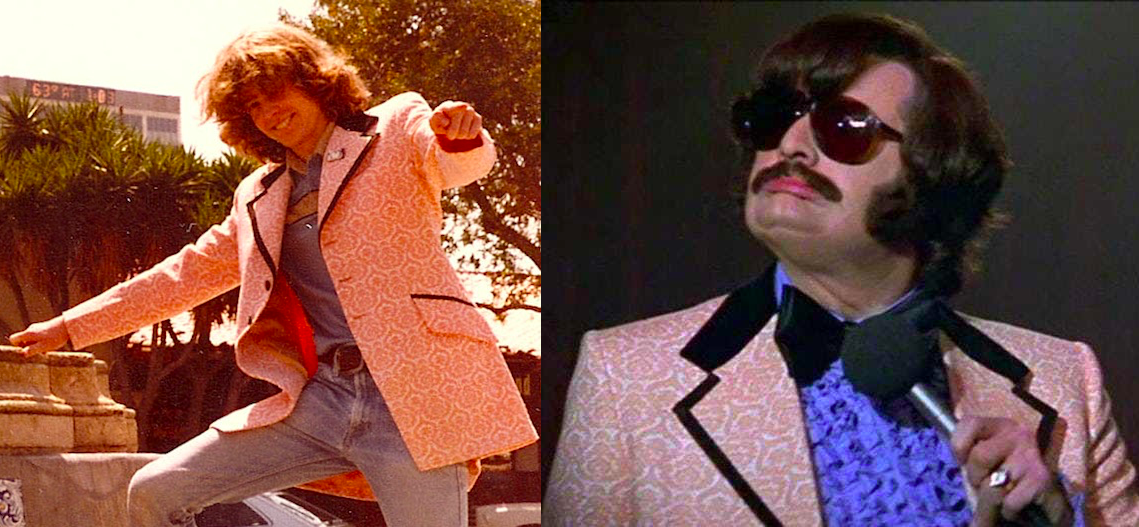
Jim Carrey and I sort of reunited a decade later when he wore my old evening jacket in the film Man on the Moon.
 |
Jeffrey C. Hause
Young Fellinis Jeffrey C. Hause (left) and partner Dave Hines (less left) pose for the The San Diego Union upon the release of their #1 movie at the US box office, Once Bitten... before Jeff leaves to work at the video counter in Sam Goody. Jeff and Dave have been writing professionally (in a very amateur fashion) for thirty years. They've written screenplays at film studios like Warner Brothers, Disney, Universal, Columbia, and Interscope; on films like Desperate But Not Serious (aka Reckless & Wild) and Tales from the Cryptkeeper, for producers such as Ivan Reitman, Samuel Goldwyn Jr. and Ray Stark. Jeff and Dave's most recents works are BachelorMan (2006) and as co-producers on Pirate Camp (2008). Jeff has also written for entertainers such as Rodney Dangerfield, Gabe Kaplan, Rick Dees, and Jay Leno. He also worked on the Lifetime Channel movie Holiday Baggage (2010) and is currently Associate Producer on the Alex Cox film Government Work (2025). |
|
|
|
